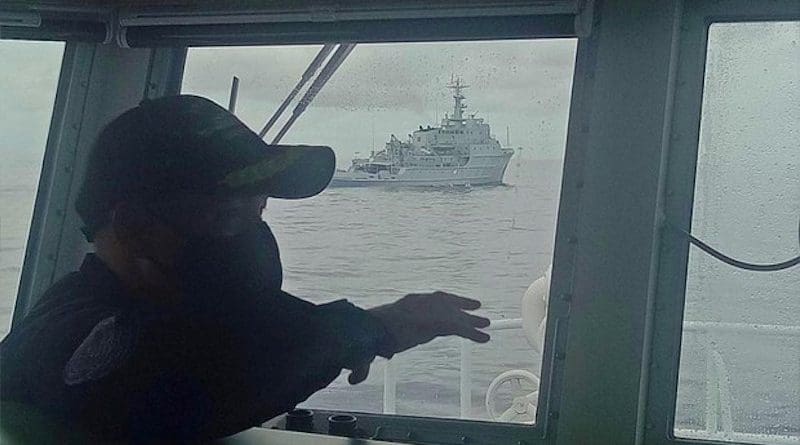Time Is Ripe For China And Philippines To Pursue Cooperation On Joint Search And Rescue Operations In South China Sea – Analysis
Despite the ongoing territorial and maritime jurisdictional conflicts in the South China Sea, China and the Philippines can really promote cooperation to strengthen friendship and maintain peace and stability in this maritime domain.
The rescue of two Chinese fishermen by Filipino fishermen off the Palawan coast on August 5, 2021 amidst the inclement weather caused by Monsoon season was an excellent example that Chinese and Filipinos could help each other in times of distress at sea. After the rescue, Filipino fishermen brought the two Chinese fishermen to a hospital in Bataraza, a small town in Palawan province, for medical treatments.
The Philippine government immediately informed the Chinese Embassy in Manila about the rescue. The Chinese Embassy was so delighted to learn the rescue of their nationals and “expressed its deep appreciation to the Philippine fishermen and authorities concerned for providing humanitarian assistance to the Chinese fishermen in a timely manner, which fully reflects their goodwill and the valuable friendship between the Chinese and Philippine peoples.”
It is not the first time that Chinese and Filipinos helped each other during distress moments in the South China Sea. In November 2016, for example, China Coast Guard (CCG) rescued two Filipino fishermen in the waters of Scarborough Shoal during bad weather.
Past and recent rescue incidents provide strong reasons for China and the Philippines to formalize and institutionalize their cooperation in the area of search and rescue operations in the South China Sea.
In fact, in the Single Draft Negotiating Text (SDNT) of the Code of Conduct (COC) in the South China Sea adopted on August 3, 2018, China and the Philippines submitted a joint proposal “for just and humane treatment of all persons in distress in the South China Sea.” This proposal strongly calls for cooperation in search and rescue operations in the South China Sea. China and the Philippines are the only parties that submitted joint proposals in the SDNT indicating the strengthening of bilateral ties between the two countries.
Another excellent example that can promote cooperation in search and rescue cooperation between the two countries is the cooperation between CCG and the Philippine Coast Guard (PCG). Since the start of the administration of President Rodrigo Duterte in 2016, CCG and PCG have maintained close contacts and frequently pursued high-level exchanges to promote cooperation in the area of capacity building, particularly on search and rescue operations, maritime safety and combating crimes at sea.
CCG and PCG have also established the hotline mechanism to intensify communication in mutually agreed areas. They have established the China- Philippines Joint Coast Guard Committee (JCGC) where both parties already held three meetings to date.
On January 14, 2020, in fact, CCG vessel 5204 visited Manila for a friendly visit — the first visit by a CCG to the Philippines. During the visit, the two parties held joint search, rescue and firefighting exercises, and had friendship sports matches to build trust and confidence.
The COVID-19 pandemic, however, delayed the implementation their planned activities for 2020. But the channels of communication between the two coast guards remain open to sustain their maritime security cooperation.
Beyond joint exercises, CCG and PCG can start negotiating for an agreement that can formalize their bilateral cooperation in search and rescue operations in the South China Sea. CCG and PCG can establish a Joint Search and Rescue Coordination Center (JSARCC) in order to establish their habit of cooperation in this field.
The International Convention for the Safety of Life at Sea (SOLAS), which was adopted in 1974 and entered into force in 1985, urges parties to provide humanitarian assistance in times of distress at sea. However, it is the International Convention on Maritime Search and Rescue (ICMSAR), which entered into force on June 22, 1985, that strongly requires parties to coordinate their search and rescue organizations. The ICMSAR encourages parties to establish their Rescue Coordination Centers (RCC) that should have “up-to-date information on search and rescue facilities and communications in the area and should have detailed plans for conduct of search and rescue operations.”
In Southeast Asia, the Association for Southeast Asian Nations (ASEAN) adopted in 2010 the Declaration on Cooperation in Search and Rescue of Persons and Vessels in Distress at Sea. The Declaration urges ASEAN members to work closely with ASEAN Dialogue partners in the area of capacity building and information exchange, among others. As an ASEAN dialogue partner, China can work with the Philippines in this field.
At present, SAR cooperation between the Philippines and China remains ad hoc and informal. The time is ripe to make their SAR cooperation regular and formal as a building block towards China-Philippines comprehensive strategic cooperation in the 21st century.

